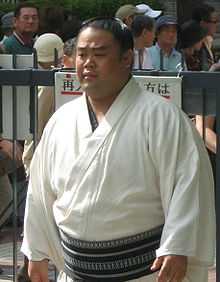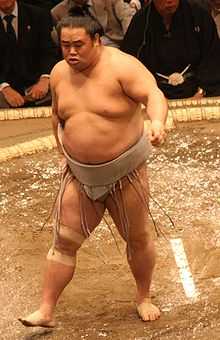Kakizoe Tōru
| 垣添 徹 Kakizoe Tōru | |
|---|---|
 | |
| Personal information | |
| Born |
Kakizoe Tōru August 12, 1978 Ōita |
| Height | 1.78 m (5 ft 10 in) |
| Weight | 139 kg (306 lb; 21.9 st) |
| Career | |
| Stable | Fujishima |
| Debut | September 2001 |
| Highest rank | Komusubi (March 2004) |
| Retired | April 2012 |
| Championships | 1 (Jūryō) |
| Special Prizes | Technique (1) |
| * Up to date as of April 2012. | |
Kakizoe Tōru (垣添 徹 Kakizoe Tōru) (born August 12, 1978 in Usa City, Ōita Prefecture, Japan), is a former sumo wrestler. A former amateur champion, he turned professional in 2001 and reached the top division in 2003. His highest rank was komusubi, which he held for just one tournament. He won one special prize, for Technique. After injury problems he fell to the third makushita division in 2011 and retired in April 2012, becoming a sumo coach. Since 2013 he is part of ex-yokozuna Musashimaru's new Musashigawa stable.
Career
Kakizoe was an amateur sumo champion at Nihon Taiiku University, winning the Kokutai (Japan Games) and the All Japan University Championship in 2000, his final year, which earned him the Amateur Yokozuna title. He joined Musashigawa stable, which at time was one of the strongest in sumo with yokozuna Musashimaru and other successful former collegiate competitors such as Dejima and Miyabiyama amongst its wrestlers. Because of his amateur success Kakizoe was given makushita tsukedashi status, meaning he was able to debut at the makushita 15 ranking. He fought his first professional bout in September 2001, fighting under his real name. Unusually, he never adopted a traditional shikona. He rose to the jūryō division in March 2003, and the top makuuchi division in September 2003.

Kakizoe's rank peaked at komusubi after the January 2004 tournament when, ranked maegashira 5, he achieved a result of 11-4 and the technique prize. He failed to retain his san'yaku rank for more than a single tournament, but mostly remained amongst the top half of maegashira for the next few years. However, he suffered a big setback in May 2007, losing eleven bouts in a row before pulling out of the tournament citing a fracture to his right knee. He could manage only six wins on his return in July and slid to the lowest rung on the top division ladder for the September tournament. He produced a comfortable 9-6 score there to maintain his top division status, but remained near the bottom of makuuchi for the next two years.
In January 2010 he rose to maegashira 4 and fought his first bout against a yokozuna since his injury. Due to the absence of Chiyotaikai and Kotomitsuki, on the final day he took part in the sanyaku soroibumi ceremony. He finished the tournament with a respectable 6-9 record, but was unable to produce a kachi-koshi or winning score in the next four tournaments either.
Kakizoe's 3-12 performance in September 2010 saw him demoted to jūryō for the first time, and he lost sekitori status after scoring only 4-11 at Juryo 9 in January 2011. Despite only scoring a make-koshi 3-4 in the May 2011 "technical examination" tournament, he was nonetheless promoted back to juryo because of the large number of slots available after the forced retirements of many wrestlers following a match-fixing scandal. However, his return to juryo was short-lived as he turned in a disastrous 1-14 score, his ninth consecutive make-koshi.
Troubled by a foot injury, he fell to Makushita 56 for the May 2012 tournament, the sixth lowest rank ever held by a former sanyaku wrestler.[1] He announced his retirement before the tournament began, and will stay in sumo as a coach at his stable under the elder name Oshiogawa Oyakata.
Kakizoe is good friends with fellow former top division wrestler Kokkai.
Fighting style
Kakizoe was an oshi-sumo specialist, preferring pushing and thrusting techniques. His most common winning move was oshi-dashi (push-out), which accounted for around 43 percent of his career victories.[2] He was vulnerable to defeat if his opponents grab hold of his mawashi.
Family
Kakizoe is married, with two children.
Career record
| Year in sumo | January Hatsu basho, Tokyo |
March Haru basho, Osaka |
May Natsu basho, Tokyo |
July Nagoya basho, Nagoya |
September Aki basho, Tokyo |
November Kyūshū basho, Fukuoka |
|---|---|---|---|---|---|---|
| 2001 | x | x | x | x | Makushita tsukedashi #15
Sat out due to injury 0–0–7 |
East Makushita #55
6–1 |
| 2002 | West Makushita #26
4–3 |
East Makushita #23
6–1 |
West Makushita #8
1–1–5 |
West Makushita #28
4–3 |
West Makushita #20
4–3 |
East Makushita #14
6–1 |
| 2003 | East Makushita #3
5–2 |
East Jūryō #11
9–6 |
East Jūryō #6
10–5 |
East Jūryō #2
11–4 Champion |
East Maegashira #11
8–7 |
West Maegashira #8
8–7 |
| 2004 | East Maegashira #5
11–4 T |
East Komusubi #1
6–9 |
West Maegashira #2
6–9 |
West Maegashira #5
7–8 |
West Maegashira #6
10–5 |
East Maegashira #2
6–9 |
| 2005 | West Maegashira #4
8–7 |
West Maegashira #2
6–9 |
West Maegashira #5
9–6 |
East Maegashira #1
7–8 |
East Maegashira #2
7–8 |
West Maegashira #2
4–11 |
| 2006 | West Maegashira #7
8–7 |
East Maegashira #6
9–6 |
West Maegashira #1
6–9 |
West Maegashira #3
4–11 |
West Maegashira #8
9–6 |
West Maegashira #4
6–9 |
| 2007 | East Maegashira #9
8–7 |
West Maegashira #6
8–7 |
East Maegashira #3
0–12–3 |
East Maegashira #16
6–9 |
West Maegashira #16
9–6 |
East Maegashira #14
9–6 |
| 2008 | East Maegashira #11
6–9 |
West Maegashira #14
8–7 |
East Maegashira #13
6–9 |
West Maegashira #15
7–8 |
West Maegashira #16
10–5 |
East Maegashira #8
5–10 |
| 2009 | West Maegashira #12
8–7 |
East Maegashira #12
7–8 |
West Maegashira #14
8–7 |
West Maegashira #8
6–9 |
East Maegashira #11
9–6 |
West Maegashira #5
8–7 |
| 2010 | East Maegashira #4
6–9 |
West Maegashira #7
7–8 |
East Maegashira #8
7–8 |
West Maegashira #9
3–12 |
West Maegashira #15
3–12 |
East Jūryō #7
7–8 |
| 2011 | West Jūryō #9
4–11 |
West Makushita #1
Tournament Cancelled 0–0–0 |
West Makushita #1
3–4 |
West Jūryō #11
1–14 |
East Makushita #9
4–3 |
West Makushita #6
1–6 |
| 2012 | West Makushita #16
3–4 |
West Makushita #22
0–7 |
Makushita #56
Retired 0–0–0 |
x | x | x |
| Record given as win-loss-absent Top Division Champion Retired Lower Divisions Sanshō key: F=Fighting spirit; O=Outstanding performance; T=Technique Also shown: ★=Kinboshi(s); P=Playoff(s) | ||||||
See also
- Glossary of sumo terms
- List of sumo tournament second division champions
- List of past sumo wrestlers
References
- ↑ "2012 May Grand Sumo Tournament Banzuke Topics". Japan Sumo Association. Archived from the original on 25 April 2012.
- ↑ "Kakizoe bouts by kimarite". Sumo Reference. Retrieved 2 August 2009.
- ↑ "Rikishi in Juryo and Makunouchi". szumo.hu. Retrieved 2007-07-24.
External links
- Kakizoe Tōru's official biography (English) at the Grand Sumo Homepage
- Kakizoe's basho results
- complete biography and basho results (Japanese)